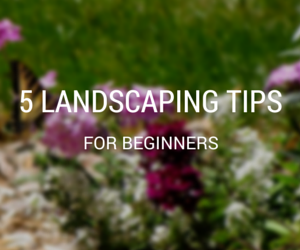5 Landscaping Tips for Beginners
 Are you intimidated by planning your landscaping project? For a newbie who wants to explore the world of landscape design, the plethora of available options can be overwhelming. However, the fundamentals that guide good design pretty much apply to your yard. Here are 5 landscaping tips for beginners. Even if you’re
Are you intimidated by planning your landscaping project? For a newbie who wants to explore the world of landscape design, the plethora of available options can be overwhelming. However, the fundamentals that guide good design pretty much apply to your yard. Here are 5 landscaping tips for beginners. Even if you’re
Settle Down and Evaluate
Take as long as you want to do this because this will become your road map for the change you want to bring about. Live with your yard for a while.
Walk around the perimeter of your property like you’re experiencing your yard for the first time. Look at the strengths and weaknesses of your yard. Make notes of your assets, for example, a nice brick patio or a lovely existing view. Once you look at the strengths look at the weaknesses. They can range from an unappealing yard or a back entry to the house that you’re not fond of. Later on, you can think about how to turn the negatives into positives. The topography of your yard is something to consider as well. Are there inclines, sunny or shaded locations?
Also, being aware of the sun and wind patterns will help you alter your landscape so that it blends into your surroundings. Let’s say your yard faces south, where you’ll see the more daylight than if your yard faced east. The southern or southeastern face of your house provides warmth in winters and sun all day in summer. Placing a patio may be a wise choice in such an area but you will also need to put appropriate shading arrangements, because these same spots might be too bright or uncomfortably hot in summers. These are the types of decisions that the staff at Best Buy In Town can assist you with.
List Out Your Needs Vs Wants
Okay, so now you know your yard well. Next, list out your needs vs wants. Having such a handy list is a great step for beginners. One can think in lines like these – Do you need a patio for family gathering or to dry your clothes? Do you want to setup a play area for your kids? Do you want to grow your own veggies? Or are you aiming at potting simple flowerbeds? Roughly sketch your ideas of where you want to place things on a piece of paper, later you can play around and do fine-tuning of these without having to start from scratch again.
Start Small
Patience is key to landscape design for beginners. You can start small on a project like carving out a small flowerbed. Go out and work on it when you have the time. Wait and watch how things progress. Once your flower bed flourishes, you can decide whether to add more or just stick with the one! Managing one is obviously easier than managing an entire area on the yard. Wanting to do everything at a single go can make you lose focus or too tired, and can get in the way of your enjoyment.
However, if the large barren space is too much to look at, opt for a quick-fix solution. Here’s a great example: large landscaping features like trees can’t really be moved, but you can experiment with small perennial. Planting shrubs makes you aware of the sun, shade and soil conditions and these shrubs can also be transplanted if the planting spot turn out to be a wrong choice. These techniques fill up your yard temporarily while you figure out long-term solutions.
Outline Attractively and Appropriately
Bright borders always can make everything else n your yard stand out. You can choose broad or slim, straight or curved borders of greenery and flowers to brighten up entrance to your home, making it more welcoming. A driveway may be filled on the sides with landscape material such as gravel or even turfstone. This gives a cleaner and distinctive look while eliminating the regular maintenance activities such as watering or weeding.
Emphasize Scale and Pacing
This is probably the trickiest principle for beginners, but scale and pacing give your yard a cohesive look. Think about objects of varying sizes, shapes, colors and lengths which can bring out the beauty of your yard. To keep the theme uniform, you may want to repeat some elements, for instance a certain plant or a common color, or shape. However, to add that ‘X-factor’ element to your landscape, you can add an occasional element that’s different from the landscape t make it stand out.
Remember that landscaping designs are fairly permanent decisions and should not be easily changed especially when it adds to the value the property. Combine these tips with some patience, thoughtfulness and your best judgments to breeze through your landscaping projects.


 Facebook
Facebook Twitter
Twitter